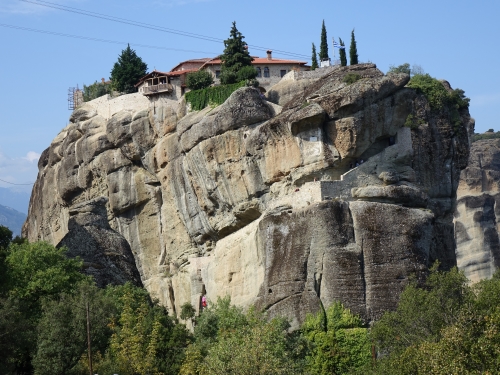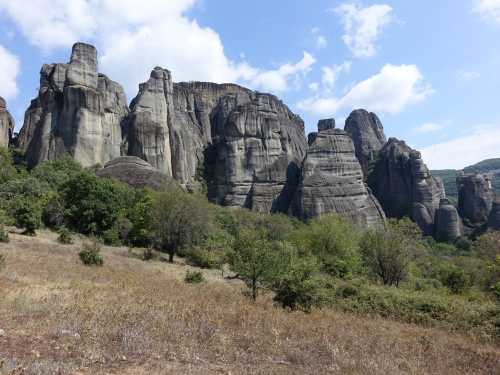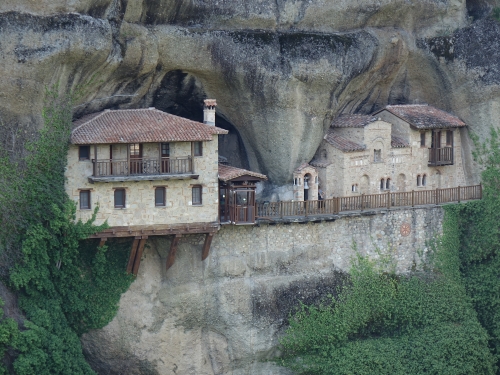Blog WHS Visits
WHS #681: Meteora
Meteora stands for a group of 7 monasteries built on high rock pillars, pillars which were created by erosion and earthquakes 60 million years ago. This is a really accessible tourist attraction (certainly a candidate for our ‘one million visitors or more’-connection, but I could not find details that confirm this) and much info on it is readily available. So I’ll just focus in this review on getting around by public transport and the enigma of the 7th monastery.

I stayed overnight for 3 nights in the town of Kastraki, which lies just in the foothills of the Meteora mountains. This proved to be an excellent choice; only for an ATM or bus connections to long distance destinations you have to walk 2km to the next city, Kalambaka. When the bus tourists are gone later on in the day, Kastraki is a cozy place with a few restaurants and always those beautiful views.
4 times a day (at 9/11/13/15h), a public bus starts from Kalambaka, stops at Kastraki (opposite to the church) and makes further stops at all monasteries. It is a normal public bus costwise at just 1.80 EUR one-way. But the company does send an English speaking guide along who takes care that everybody leaves the bus at the right monastery. Also, there is a 10 minute stop at a view point included. This all combined results in a journey of about 50 minutes for the 8km stretch from Kastraki to the furthest monastery, St. Stephen’s. From there, I walked back all the way down visiting 4 of the monasteries along the road.

While preparing for the visit to this WHS, I noticed that there are 7 monasteries named at the map at the UNESCO website. This differs from the 6 that are generally mentioned in tourist literature and were also in my original introduction text on this website. However I found no precise location or more common name for this enigmatic ‘Monastery of the presentation of Jesus Christ’.
Coincidentally I joined a Meteora hiking tour on the second day of my stay in the area. This is a very recommendable hike of about 3h walking plus 1.5h visiting 2 monasteries, the Great Meteora and Ipapantis. I am now fairly sure that the monastery of Ipapantis is the 7th monastery that is meant in the nomination. It lies virtually at the back of the mountain of the Great Meteora and was a kind of annex to it: a smaller rock-cut setting where monks could retreat to from the busy Great Meteora monastery. Ipapantis has only opened to tourists since last year. It lies somewhat off the main road and therefore is only accessible to hikers. It is not in religious use anymore and there also is no entrance fee. There is a caretaker though who shows you around. The monastery has been restored in the year 2000 and is in very good condition. The church is completely original and lovely. There was only space for 8 monks up here.

In general, I preferred Meteora's natural setting above its monasteries. Of course it was very clever that the old 'Meteorites' founded their churches and monasteries on these peaks – and all that without the access roads of today. But the monasteries are barely functioning as such anymore and their interiors most of the time aren’t worth the repeated 3 EUR entrance fee, except for a single church covered with murals such as at Rousanou.
Els - 9 October 2018
Comments
Els Slots 9 October 2018
Thanks Solivagant for both additions. I knew I could rely on you for fact checking!
Solivagant 9 October 2018
"certainly a candidate for our ‘one million visitors or more’-connection, but I could not find details that confirm this)"
Indeed. This IUCN document (see "current threats") states "Large numbers of visitors, around two million per year, flood the site (conventional forms of tourism mainly, but also partly related to religious, cultural, eco-tourism, and sports tourism) (Lyratzaki, 2007)"
https://www.worldheritageoutlook.iucn.org/explore-sites/wdpaid/18862
Solivagant 9 October 2018
"However I found no precise location or more common name for this enigmatic ‘Monastery of the presentation of Jesus Christ"
It is indeed "Ypapantis" (or "Hypapanti, Hypapante").
This is fairly common title for Churches in the Greek Orthodox tradition - "In the Eastern Orthodox Church, the Presentation of Jesus at the temple is celebrated as one of the twelve Great Feasts, and is sometimes called Hypapante (Ὑπαπαντή, = "Meeting" in Greek). In Western Christianity, the additional name for the Service the day, Candlemas, is added. " (Wiki)